|
|
CORMORANTS, HERONS, AND EGRETS
Cormorants |
|
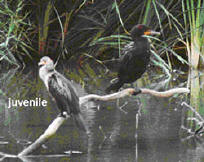 
Double-crested Cormorant
(Family Phalacrocoracidae) These are large, dark brown colored birds that have set-back legs for swimming and diving. They have long hooked bills for fishing and a yellowish bare facial skin and throat patch. Sometimes they will swim submerged with only the neck and head above water. They will frequently perch on branches, fences or powers lines with their wings spread open to dry their feathers. The young birds (1st year adults) have lighter throats, breasts and bellies than the adults. The adults in breeding plumage have a whitish crest or tuft on either side of the head. An adult with a juvenile are pictured here perched on a branch in a brackish marsh |
|
|
Herons and Egrets
|
|
|
This wading bird is the stockiest of the herons and has a short neck and short legs. The adult has a black crown and beak with dark red eyes, whitish neck and breast, black and grey wings, and yellow legs. The breeding adult has 1-4 long white plumes on the back of the head. The juvenile and 1st year adult has speckled brown plumage. These birds can be seen throughout the day but forage more commonly during the night. They roost and breed in cattails, tules, coyote bush, and other medium sized shrubs and trees. They forage on small fish, invertebrates, amphibians and small reptiles. |
|
|
|
|
|
This very large egret is similar in size to the Great Blue Heron. They have all white plumage, bright yellow bill, black legs, and a very long neck. The breeding adults grow long tail plumes and have greenish yellow bills. This heron also requires large old trees or thick stands of willows to nest and roost in. This bird was almost hunted to extinction in the 1950's for its feathers to make hats and other accessories. They forage on fish, invertebrates, amphibians, reptiles and small mammals. They have a deep gravelly, croaking voice. |
|
|
|
|
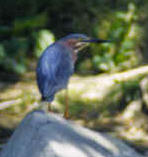 Green-backed Heron
(Family Ardeidae) Green-backed Heron
(Family Ardeidae)Butorides striatus L: 18" W: 26" A small heron with blue-green top back and brown neck and cheeks. This bird has a long pointed bill. The feet and legs are yellow. Immature birds are brown on top and streaked on their underside. A solitary bird, found along streams, in ponds, and in marshes with vegetated cover. |
|
GEESE AND DUCKS
Geese |
|
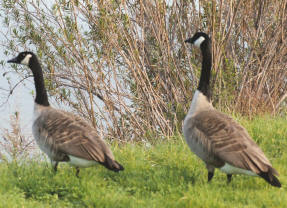 Canada Goose Canada GooseBranta canadensis L 25-45" WS 43-60" This large, common, and widespread goose is found in many fresh and salt water environments in the San Francisco Bay area. It was once a migratory species but many remain through the year. These geese have long black necks and black beaks with a white cheek. Their backs and chest are light brown or beige and they have black and white tail feathers. They have webbed feet for swimming. They flock together in V patterns and can often be heard calling out to one another with a loud honking call. They nest on the ground in grassy or marsh areas. They eat vegetation both on land and in water. |
|
Dabbling Ducks |
|
|
This large, heavy, dabbling duck feeds along the surface of the water and with its head under water and tail up in the air, eating aquatic plants, seeds, snails, and crabs. The breeding adult male duck has a dark green head with a white neckband, yellow bill, and a pale body with a white tail. The female, juvenile, and non-breeding male are medium brown with a brown eye stripe, yellow bill, white tail, bold bluish wing stripes, and orange legs and feet. They can spring into flight right out of the water. Their wings give a whistling sound when in flight. |
|
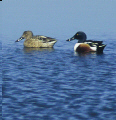 Northern shoveler
(Family Anatidae) Northern shoveler
(Family Anatidae)Anas clypeata L: 19" A common marsh duck distinguished by its large spatula shaped bill. The male has a green head, yellow eyes, white breast, and brown sides. The female has mainly brown coloring with green speculum on its wings. These dabbling ducks eat sedges, grasses, crustaceans, mollusks, algae, and insects. |
|
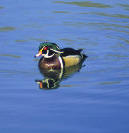 Wood duck
(Family Anatidae) Wood duck
(Family Anatidae)Aix sponsa L: 18.5" The male duck has distinctive plumage and a crest of brilliant colors. The head and crest are green with white streaks, and the throat is white. The breast and neck are brown while the flank is a buff color with black and white bands in front. The eye and upper bill are red. The female is light brown with white teardrop shaped eye patches. Locally found in ponds and creeks as well as adjacent woodlands. These dabbling ducks can be found foraging for food in freshwater marshes adjacent to brackish water sloughs and waterways. |
|
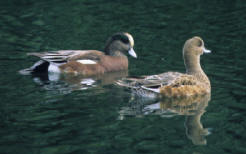 American Wigeon
(Family Anatidae) American Wigeon
(Family Anatidae)Anas americana L: 19" A common medium size duck. The male has a white cap and forehead with a green stripe running from the eye to the back of the neck. These markings are absent from the female. Both sexes have a buff colored breast and sides, white axillaries, and a green colored speculum. |
|
Diving Ducks |
|
|
|
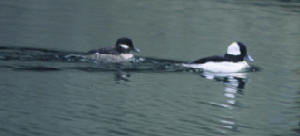 Bufflehead
(Family Anatidae) Bufflehead
(Family Anatidae)Bucephala albeola L: 13.5" A fairly common small duck with a short bill, and large head. The male has a black underside with a large white patch towards the back of the head. The female is more subdued with a smaller white head patch. They are small diving ducks that eat mollusks, crustaceans, snails, fish, and insects. |
|
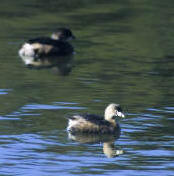 Pied-billed Grebe
(Family Podicipedidae) Pied-billed Grebe
(Family Podicipedidae)Podilymbus podiceps L: 13.5" A small swimming and diving bird, with a dark brown top half and a lighter brown underside. This grebe has a diagnostic black ring around a whitish bill. It is found in ponds, sloughs, and larger creek areas where they catch fish as their main source of nutrition. |
|
NEW WORLD VULTURES, HAWKS, AND KITES
|
|
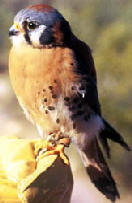 American Kestrel
(Family Falconidae) American Kestrel
(Family Falconidae)Falco sparverius L: 11" W: 23" A small falcon with pointed wing tips and long tail. The male has a rusty colored back and tail. The bluish gray wings are found on male birds with their two black stripes on a white face. The females are all the same type of rusty color. Common in open area and often seen hovering above potential prey, including insects, reptiles, and small mammals. |
|
|
The easiest way to identify this large bird (kite) is by its white tail rump that is seen as it is flying away. They also have a very distinctive owl-like facial disk in all ages and in both sexes. The adult male is gray above and mostly white below while the female is brown above and mostly white or light brown below. The juvenile is similar to the female but has darker, cinnamon plumage. These birds tend to fly low to the ground looking for small mammals, birds, amphibians, and other small prey. |
|
|
A large soaring bird with a featherless red-orange head. They hold their wings in a V-shaped wing span design when flying. Their two-toned wing color seen from below helps in identification along with their red head and white bill. Their hooked bill and bare head aids them in consuming carrion. |
|
PLOVERS, STILTS, AND AVOCETS
|
|
|
|
|
|
This is a sleek, tall, wading bird with a long, recurved bill. The non-breeding adults have black and light gray wings with a gray body and legs. The breeding adults obtain a reddish cinnamon head and neck. They use their long bill to sweep side to side in the mud flats and shallow water to feed on invertebrates and small fish. They have a loud wheet call and are common in shallow ponds, sloughs, marshes, and lakeshores. |
|
|
|
MARSH, RIPARIAN, AND UPLAND BIRDS
|
|
|
This small long-legged, short-tailed owl is the only species likely to be seen in the daylight. It can be seen coming out of its burrows in the levee or perched on a wooden fence pole. It has a flat head, narrow wings, pale eyebrows, white throat, barred and spotted dark brown and buffy breast and back. The male calls with a high trumpeting coo-cooo on one note. The female answers with a short eeep or a harsher, raspy, one note call. These owls can also be seen in open grasslands. They nest and roost in abandoned burrows of other animals like the ground squirrel. |
|
|
Flycatchers, such as the Black Phoebe, have whisker-like feathers near their bill to help them "feel" insects while flying in the air. The Black Phoebe has a black head, body with a whitish belly, and undertail coverts. The juveniles are browner and have wing bars. It can often be seen perching close to the ground or near water catching insects. It has a very characteristic tail dipping motion when perched. Its soft four-syllable song sounds like a rising and descending pee-wee. It often calls with a loud, one note tseee. |
|
|
This small, insect eating bird has a slender body and long pointed wings. It is a graceful swallow with a long, forked tail which helps it swoop and turn quickly to catch insects over water or land. Its back and wings are blue-black and the chest and belly are whitish to orange with a darker orange throat. It is an aerial bird but sometimes is found perching on wires or posts. It is commonly found near bridges, and overpasses near water. The nest is a partial bowl of mud that can be found under bridges, cliffs or other human-made structures. |
|
|
A small bird with a slender body and long pointed wings, found flying or perching on wires or posts. Its coloring is a glossy blue-black above and with a puffy throat, breast, and rump. The square tail is a distinguishing feature from the barn swallow. Commonly found nesting under bridges or overpasses near water. Its nest is composed of mud and in colonies. These agile flyers capture insects for food. |
|
 Common Raven
(Family Corvidae) Common Raven
(Family Corvidae)Corvus corax L: 24" This is a large black crow-like bird. Differentiated from crows by its larger size, heavier bill, and wedge-shaped tail. It is found in various habitats and feeds on a wide variety of food including carrion. It is widespread, naturally occurring worldwide. They are distinguished from other raven species by their robust bill and their frequent, harsh, croaking calls. |
|
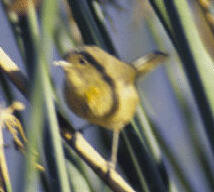 Common Yellowthroat
(Family Parulidae) Common Yellowthroat
(Family Parulidae)Geothlypis trichas L: 5" This is a small perching bird with olive-colored upper parts, and yellow under parts. The male has a black mask that wraps around the front of the head, across the top of its bill. This species is found in dense patches of reeds in marsh habitats where it is more often heard than seen. |
|
|
Wrens are small, chunky birds with sharp slightly curved bills. They have flat, uplifted tails that are usually striped with dark or black feathers. Most species are more easily heard than seen and have a loud, melodic song to defend its territory. The marsh wren is common in cattails and other tall grasses and vegetation. It has a white eyebrow, dark rufous brown wings and tail with a buff colored chest. |
|
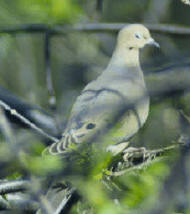 Mourning dove
(Family Columbidae) Mourning dove
(Family Columbidae) Zenaida macroura L: 12" The most common dove species in this area. A slender bird with long tapering wings and tail. Both sexes are gray and buff colored on the top half of their body, buff on the underside with a pinkish hue on the breast. They also have black spots on their upper wings. The call is a soft cooing sound. They are monogamous. The female generally lays two small, white eggs in an open nest. |
|
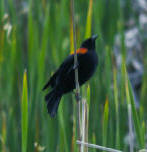 Red-winged Blackbird
(Family Icteridae) Red-winged Blackbird
(Family Icteridae)Agelaius phoeniceus L: 8.75" The male is a glossy black with red shoulder patches edged with yellow. Females are brown above with a streaked brown underside, and may have areas of slight reddish color. During mating season males display their shoulder patches by flaring their feathers and holding their wings outward. Commonly found in marshes, sloughs, and open grassy fields. They are omnivores consuming a wide variety of foods. |
|
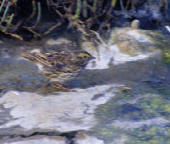 Savannah sparrow
(Family Emberizidae) Savannah sparrow
(Family Emberizidae)Passerculus sandwichensis L: 5.5" A small brown bird with a brown streaked upper breast and sides. There are no wing bars, but they have yellow lores and eye brows. Their feet and legs are pink. Commonly found in more open areas of (less vegetated) marshes and fields. |
|
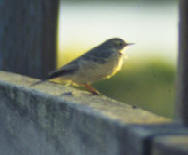 Water pipit (Family Motacillidae) Water pipit (Family Motacillidae)Anthus spinoletta L: 6.5" A small sparrow like bird with brownish gray back, wings, neck and head, buff colored underside and throat with brown streaking on the breast, sides and neck. The pipit has a buff colored eye stripe and eye ring. The bill is a dark gray and the feet and legs are pink. They are locally found in open marshland and fields in search of insects and seeds. It pumps its tail up and down as it walks. |